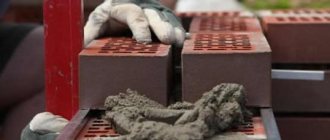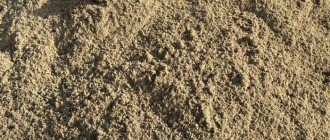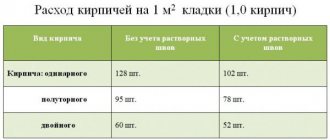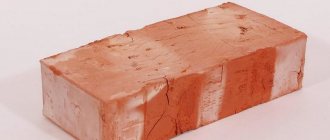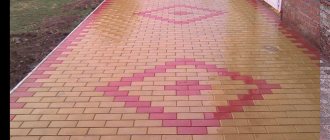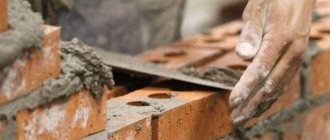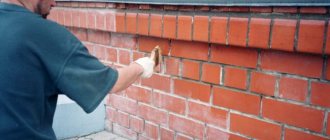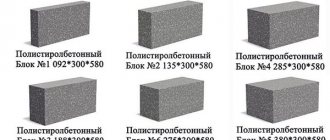A private house made of red brick with white seams looks impressive, voluminous and expensive. This is a classic facade design option that you can do yourself. White seams set off the stone, highlighting its texture, size, and clarity of lines. The only drawback of the color scheme is the fragility of the visual effect; over time it acquires a grayish tint. It is created using grout or a solution of the desired color. The finished mixture can be purchased at a hardware store or made with your own hands with the addition of white sand and lime. Light joints work best with brown, red and other dark bricks.
The meaning of color scheme in a brick wall
The white seam of the brickwork is used to enhance the decorative effect. With its help, the texture, color, and material of the stone are emphasized. It highlights every element and makes a dark brick house more presentable. The expressiveness of the texture is emphasized by the shade of the seam. The combination with red in construction has always been considered a classic. Gray or black seam blends into the elements and does not visually set off brown or other dark building material. At the same time, the brick facade looks dull.
It is important to consider that light-colored seams quickly become dirty and gray. For visual effect, it needs to be updated regularly.
White highlights red, brown and black brick. A similar effect is mainly used for exterior decoration, but is also found in the interior decor of rooms with a brick wall. When building a fireplace with this combination, you should remember the impracticality of a light shade and its possible rapid contamination. It is enough to use a solution of a color so that the surface of the building looks unusual without the use of mosaics or modeling. Light joints in brickwork are found during construction:
This design of seams decorates a brick fence.
- private houses;
- non-residential objects (for example, courtyard buildings);
- fences;
- columns and other architectural structures.
Return to contents
What solution is needed?
White mortar for laying bricks can be purchased in a ready-made version at the store or made with your own hands. It consists of white sand, lime and cement. Plus, special admixtures are added to ensure the strength of the masonry. It perfectly shades the masonry with brown color, enhancing texture and scale. There is a wide selection of ready-made mixtures on sale that do not require additional components and guarantee color purity. It is important to remember that when making a solution you should be careful about the concentration of ingredients, which affects the strength and reliability of the masonry.
How to make white mortar for bricklaying?
White mortar for bricklaying is used to decorate country buildings. To give greater expressiveness to the masonry, use different colors of mortar, not just white. For each type of brick you can choose a suitable design. How to get a colored seam?
Colored grout looks much better than regular gray, which is why they are often used to decorate the front sides of a house.
How to make a white brick joint?
The best option is to initially use white mortar when laying bricks. In this case, you need to control the size of the seam and its evenness. Slaked lime, which is added to the cement mixture, creates the desired whiteness. The more lime, the richer the color. The effect can be enhanced by increasing its amount in the solution or by adding nitric oxide or titanium. But the proportions must be respected, otherwise the masonry will lose strength. If a gray mortar is initially used during construction, then special white grouts are purchased to give a light shade. When the masonry is finished, they rub over the seams. It is worth remembering that it is impossible to achieve a perfectly snowy shade in this way. There are special compositions for treating brick walls, with which you can achieve the desired color. With their use, the wall will wear out less and lose its appearance.
White mortar for bricklaying is used to decorate country buildings. To give greater expressiveness to the masonry, use different colors of mortar, not just white. For each type of brick you can choose a suitable design. How to get a colored seam?
Preparing the solution
The color of the grouting solution is determined after the masonry is completely completed. But in general, you can choose the color scheme at the stage of choosing a brick. It is better to buy materials that match each other in color as closely as possible; they should be in harmony with each other, and not make you want to immediately look away from the wall of the house. But often designers experiment with a combination of two bright contrasting colors, and such experiments often look very impressive and beautiful.
Contrasting grout for seams
On a note! If the desired color was not available, then you can grout the seams with ordinary cement-sand mortar. In any case, it will look nice, as it has a grayish natural color that is in harmony with all other shades.
To prepare the mixture itself, which will be used to grout the joints on the brickwork, you will need the following components:
- high quality cement - 4 buckets;
- clean fine sand - 2 buckets;
- dry ready-mix for preparing grout mortar;
- clean water - about 6 liters.
Note: the volumes of materials are approximate, but will allow you to roughly calculate costs.
Cement-sand mortar
To prepare the solution, you need to carefully sift the sand using a fine sieve, removing large fractions and possible debris from it. One part of the entire sifted material must then be mixed with two parts of dry cement, after which a little water is added to this composition and everything is mixed to a thick mixture of uniform consistency with a construction mixer. Then the grout mixture and water are added, and everything is thoroughly mixed again.
The finished mixture should be allowed to brew. After the solution swells a little, having absorbed the liquid, it is mixed again. That's it, the solution is ready for use.
Quick Mix series VK 01 – Masonry mortar with route for facing bricks
Prices for cement and basic mixtures
Cement and base mixtures
About the use of white color and its importance
Despite the fact that brickwork even by itself looks quite presentable, almost 15% of the brick wall will be occupied by stripes - seams between the elements. The classic version of brickwork has a dark red color and a white seam, which visually separates the elements from each other. Thanks to this combination of colors, the entire structure will be perceived completely differently - details, volume, shadows and texture of materials will be visible.
If you choose the wrong color for the seams, then the masonry will lose its appearance, become faded and inexpressive, and the appearance of the building will fade. Over time, under the influence of external factors and weather, the seam will turn gray, after which it will lose its attractiveness. The gray seam practically does not separate the elements, so the feeling of volume and expressiveness of forms disappears. This is how only 15% of the masonry area can affect the visual perception of the entire structure. It is worth remembering that attention to small details helps improve the perception of many buildings.
Fortunately, you can avoid all of these unwanted faded visual effects by choosing the right seam materials.
How to create a white seam?
If you want to decorate your dark brick home with white joints, choose your additives very carefully. Also, the classic version of a pure white seam can be made using the following methods:
White color helps to emphasize the volume and texture of the structure, thanks to it it is possible to highlight the details and individual elements of the wall, which is why it is used so often with red, orange and brown brick.
You can get it in the following ways using a standard masonry solution:
- add more slaked lime;
- use nitric oxide in the composition;
- get titanium oxide.
Unfortunately, each option is costly in its own way.
House made of dark bricks with white joints
Look at the facade of a frame house made of dark brick with white seams in the photo. And if you look closely, you can catch a subtle combination of two shades - a very dark one, almost close to black, and a classic dark brown color. The attractive appearance of the façade of this building is achieved by combining dark brickwork with white wooden decorative elements, gutters, roller shutters, platbands and shutters in the window frames. White unusually harmoniously balances the severity and severity of dark brick.
Cooking tips
White masonry mortar for bricks can be created in different ways, but you will have to spend a lot of money on the components of the mortar. The highest quality white color is produced by titanium oxide in solution. The whiteness of such a mixture does not disappear for decades.
- To create a high-quality white masonry mortar, you will have to mix two types of mixture. The first will be on a cement-sand base, and the second is made on the basis of white M500 cement with dye additives (titanium oxide).
- When laying, both mixtures are used, but in a certain order.
- When laying bricks, the inner part is filled with the first mixture with sand, and the second is covered with the outer part of the brick. The quality of construction is not lost, but the appearance changes.
The adhesion of materials will not allow one type of solution to separate from another until it dries completely. In addition, if the house is made of dark brick, various traces of dye will not be visible on it, which happens in some cases if you add the wrong component to the mixture, since the solution will not flow.
Colored masonry mortars
Having appeared on the construction goods market, colored brick quickly gained well-deserved popularity. It began to be used everywhere for finishing facades. It was only necessary to solve one problem - the usual gray paneling negates all the beauty of this finishing material. We tried the option of filling the seams with white sealant or finishing facade plaster. However, it required more time resources and increased the cost of work.
Building material manufacturers quickly responded to market demand and developed colored mortar for bricklaying. Its composition: high quality white cement with pigment and polymer additives. The dyes used in the solutions are of high quality, so the material is quite resistant to moisture and perfectly retains its original color. Due to polymer additives, the problem of solution shrinkage is solved.
Due to their properties, colored mortars for laying ceramic bricks are in great demand when finishing facades, because... They are easy to use and come in a variety of gorgeous colors.
Mixing the solution
You will need for the solution:
- white cement;
- dye;
- sand;
- water;
- capacity;
- kneading tool.
Don’t try to make a solution right away, as it probably won’t work. Mix samples in small containers to check the final color.
The composition of the mixture will be with the following proportions: cement to sand 1:3. In this case, the dye should not be more than 10% of the amount of cement. The sand should be clean, river, medium size. Mix all the ingredients dry, and then gradually add warm water to obtain the required consistency. Let it sit for a while, then stir it in, and you can start laying.
Another option is to stir the dye separately in water until the small particles dissolve in the liquid. Then the components of the mixture are gradually poured into one container: half cement, 1/3 sand, and the rest is dye.
Coloring the solution
This method is good because it reduces the labor intensity of the work - the white seam in the brickwork is obtained directly during the construction of the facing structure.
In order for the cement mortar to become white, coloring components must be added to it. They may be:
- slaked lime, which is known to increase the plasticity of the solution and improve its performance properties;
- colored masonry colors are one of the ways to give cement mortar any shade. The point is that expectations may not be met - strict adherence to the proportions of preparing the mixture is required, the best effect is achieved when using special white cement, against which the color will be most visible;
- Titanium oxide is a universal bleach that can perfectly lighten the cement mass.
The listed components will help to make a white seam during masonry, which will save time and labor costs, but you will have to pay for it - additives are needed in significant quantities, which increases the cost of the working material.
The best option is to use titanium oxide. This component is not washed out and does not affect the strength of the wall in any way. In addition, you won’t have to expect any unpleasant surprises from the solution - delamination, the formation of efflorescence (as when adding lime).
Preparation and laying
To make masonry mortar white and reduce material consumption, masons use 2 types of working mixture at the same time - classic and colored.
Gray cement-sand mortar is prepared using traditional technology. It is placed on an invisible part of the masonry.
To make the white mixture, you need to prepare:
- white cement grade M500 - 1 part;
- titanium oxide (whitewash) - no more than 10% of the amount of cement;
- sand - 3 parts;
- water as needed.
The dye is dissolved in water and the sand is mixed with cement, or the dry component is mixed with a binder before mixing with the liquid.
A house made of red or brown brick with white joints can be faced using exclusively white mortar or it can be laid only on the outside of the masonry surface.
White clinker
Sand-lime working brick has good density. A building constructed from such material is endowed with all the necessary qualities for people to live in it. The house is strong, durable, retains heat, protects from noise and environmental influences. But for complete completeness and an aesthetic appearance, it lacks an elegant finish. White clinker brick is an excellent facing material.
A perfectly flat and smooth surface is ensured by the low porosity of the stone.
Unlike sand-lime brick, clinker brick almost does not absorb moisture. This feature makes it resistant to the external environment; it does not react to precipitation, frost and icing.
Thanks to the high technical characteristics of the facing stone, the decoration of buildings occurs impeccably. Precise geometry, neat shape, absence of scratches and chipped corners meet the most stringent requirements for appearance.
Models of facing bricks that imitate chips and reliefs have the same ideal angles and contour lines as standard clinker.
White sand-lime brick
Cheap and effective building material. It is made from sand, lime, with a small addition of additives. High temperature technology allows sand to melt, turning it into a glassy mass. This process allows the material to acquire a special density, twice that of red stone.
In addition to density, sand-lime brick has many other positive qualities:
- it can easily withstand increased loads;
- unlike red brick, it retains heat optimally;
- has an excellent appearance and stable color, on which the release of salts and dust formation is almost invisible;
- the material is made from environmentally friendly components, which allows you to feel comfortable in such buildings;
- it is frost-resistant, has good sound insulation;
- the cost of white brick is lower than red;
- this is an excellent building material for both load-bearing walls and internal partitions; concrete floors can be installed on it (which is not recommended when using cinder block material).
Disadvantages include low resistance to moisture. Therefore, when building a house from white brick, the ground floor will have to be built from red. Such material is not suitable for the construction of cesspools, basements, underground communications, wells, and all structures that may have direct contact with water or sediment. The underground part of the house must be separated from the residential part by waterproofing. Poor resistance to moisture can be solved with thoughtful ventilation and an efficient heating system.
In addition, sand-lime brick is not used in places with direct contact fire (stoves, barbecues, fireplaces).
White stone is less durable than red stone. But it has its advantages. In terms of the ratio of masonry volumes, silicate is more advantageous in price. It is not difficult to calculate the masonry. A cubic meter contains 340 pieces of white brick (mortar is taken into account) or 410 red. This difference is characteristic not only of the price of the material, but also of the concentration of effort with which the building will be built.
Beautiful design options for brick houses
White buildings look elegant and festive, but adding a different color adds brightness to the building and creates a certain style. Brick houses come from the distant past, and many historical styles are reflected in modern buildings.
Gothic
During the formation of the Gothic movement, brick was the most popular building material. At that time, architecture was not decorated with sculptures; buildings were decorated with color contrasts, different textures of stone, and the addition of plaster. The romance of the period of medieval castles left its mark on this direction. Elongated windows like loopholes, elevated vaults, and the presence of openwork forging make the building unusual and mysterious.
Baroque
The bright building in the Baroque style is designed with the pomp characteristic of this style. The rich facade is decorated with buildings imitating ancient towers with bay windows. Roofs and balconies framed with carved forging, majestic steps, columns and flowing architectural lines give the building a regal appearance.
Provence
The house is made of light brick in the French country style and is made of natural materials in pleasant warm shades. Buildings are usually built with two or three floors, including an attic. The first floor is given over to the kitchen, bathroom, change rooms, and upstairs there are bedrooms. The multi-pitched roof is covered with tiles. Landscape design surrounding the house is of great importance in the Provence style.
Choosing white brick to build your home means choosing a daily holiday that gives an elegant and elegant look to a beautiful facade.
Tips for laying bricks - in the next video
